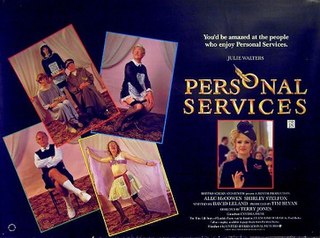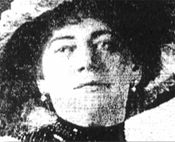
The Everleigh Club was a high-class brothel which operated in Chicago, Illinois from February 1900 until October 1911. It was owned and operated by Ada and Minna Everleigh.

Storyville was the red-light district of New Orleans, Louisiana, from 1897 to 1917. It was established by municipal ordinance under the New Orleans City Council, to regulate prostitution. Sidney Story, a city alderman, wrote guidelines and legislation to control prostitution within the city. The ordinance designated an area of the city in which prostitution, although still nominally illegal, was tolerated or regulated. The area was originally referred to as "The District", but its nickname, "Storyville", soon caught on, much to the chagrin of Alderman Story. It was bound by the streets of North Robertson, Iberville, Basin, and St. Louis Streets. It was located by a train station, making it a popular destination for travelers throughout the city, and became a centralized attraction in the heart of New Orleans. Only a few of its remnants are now visible. The neighborhood lies in Faubourg Tremé and the majority of the land was repurposed for public housing. It is well known for being the home of jazz musicians, most notably Louis Armstrong as a minor.

A brothel, bordello, ranch, or whorehouse is a place where people engage in sexual activity with prostitutes. However, for legal or cultural reasons, establishments often describe themselves as massage parlors, bars, strip clubs, body rub parlours, studios, or by some other description. Sex work in a brothel is considered safer than street prostitution.
Betty Jean O'Hara was a famed prostitute in Honolulu's "vice district" during World War II.

Personal Services is a 1987 British comedy film directed by Terry Jones and written by David Leland, about the rise of a madam of a suburban brothel which caters to older men. The story is inspired by the real experiences of Cynthia Payne, the "House of Cyn" madam.
Cynthia Diane Payne was an English brothel keeper and party hostess who made headlines in the 1970s and 1980s, when she was convicted of running a brothel at 32 Ambleside Avenue, in Streatham, a suburb in south London.

Baltimore's The Block is a stretch on the 400 block of East Baltimore Street in Baltimore, Maryland, containing several strip clubs, sex shops, and other adult entertainment merchants. During the 19th century, Baltimore was filled with brothels, and in the first half of the 20th century, it was famous for its burlesque houses. It was a noted starting point and stop-over for many noted burlesque dancers, including the likes of Blaze Starr.

The Levee District was the red-light district of Chicago from the 1880s until 1912, when police raids shut it down. The district, like many frontier town red-light districts, got its name from its proximity to wharves in the city. The Levee district encompassed four blocks in Chicago's South Loop area, between 18th and 22nd streets. It was home to many brothels, saloons, dance halls, and the famed Everleigh Club. Prostitution boomed in the Levee District, and it was not until the Chicago Vice Commission submitted a report on the city's vice districts that it was shut down.

Mattie Silks, or Martha Ready, was a prostitute and leading madam in the late 19th century American West.
Ah Toy (Chinese: 亞彩; Sidney Lau: Aa3 Coi2; 18 May 1829 – 1 February 1928) was a Chinese American sex worker and madam in San Francisco, California during the California Gold Rush, and the first Chinese sex worker in San Francisco. Arriving from Hong Kong in 1848, she became the best-known Asian woman in the American frontier.

Lulu White was a brothel madam, procuress and entrepreneur in New Orleans, Louisiana during the Storyville period. An eccentric figure, she was noted for her love of jewelry, her many failed business ventures, and her criminal record that extended in New Orleans as far back as 1880.

Ada and Minna Everleigh, born Ada and Minna Simms, were two sisters who operated the Everleigh Club, a high-priced brothel in the Levee District of Chicago during the first decade of the twentieth century. Ada, the eldest, was born in Greene County, Virginia on February 15, 1864, and died in Charlottesville, Virginia on January 5, 1960. Minna was born in Greene County on July 13, 1866 and died in New York City on September 16, 1948.

Josephine "Chicago Joe" Airey, was an Irish-born American prostitute, madam, and proprietor of brothels, dance halls, a variety theatre, and saloons in Helena, Montana. She eventually became the most influential landowner in Helena. She was known as "Chicago Joe" Hensley following her marriage to James T. Hensley.

Teresa Susan Donohue, better known as Tessie Wall was an American madam who owned and operated brothels in San Francisco, California, from 1898 to 1917. She was married to gambler and political boss Frank Daroux, whom she attempted to kill in 1917 as he sought to divorce her. In the 1920s she was the unofficial "queen" of the annual policeman's balls that were held at the Civic Auditorium. She was the most successful madam in San Francisco in the early 20th century.

The Gleim Building, 265 W. Front St., Missoula, Montana, was a brothel constructed in 1893 for Mary Gleim, a notorious madam who owned at least eight "female boarding houses". This building serves as an example of a vernacular adaptation of Romanesque architecture.

Dorothy Josephine Baker, also known as Big Dorothy, was an American madam in Helena, Montana in the mid-20th century. She ran a brothel officially known as "Dorothy's Rooms" on Last Chance Gulch in Helena from the mid-1950s until it was shut down in a police raid in 1973. While running the brothel, she also donated to many charities, including churches and law enforcement programs, making her generally popular among the local citizens.

Lizzie Lape was a mid-Ohio madam who owned and operated multiple bordellos at the end of the 19th century and early into the 20th.

The Dumas Brothel was a brothel in Butte, Montana. The brothel was founded by French-Canadian brothers Joseph and Arthur Nadeau in 1890 and named after the nominal owner, Delia Nadeau, née Dumas, who was Joseph's wife. It grew considerably through the years, with the miners employed by the city's copper mines often patronizing the establishment. After several changes of the "madams" and continuing pressure from authorities, the brothel closed in 1982, described as "a rare, intact commentary on social history". At the time of its closure, it was the longest operating brothel in the United States, having operated years after prostitution was made illegal. After closing, the brothel changed hands several times, eventually becoming a tourist attraction owned and managed by a series of Butte residents.
Willie Vincent Piazza was a sex worker and brothel proprietor in the Storyville during that red light district's period of legal operation. From 1898 until the district's closure in 1917, Piazza worked as a madam and specialized in providing octoroon women for her clients; she herself was mixed-race.
Ida Mary Dorsey, also known as Ida Burkes and Ida Pillsbury, was an American madam who operated five successive houses of prostitution in Minneapolis, Minnesota. Dorsey's life came into focus when Penny Petersen published Minneapolis Madams: The Lost History of Prostitution on the Riverfront in 2013.














